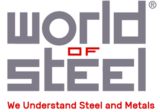For many years, galvanized articles made by hot-dip coating techniques were identified by a characteristic spangle appearance. In some cases, this is still true today.
However, because of changes in the zinc refining process, in the galvanizing process, in the demands of the marketplace, and health concerns, relatively little hot-dip galvanized steel sheet made today has a visible spangle.
The dictionary defines “spangle” as a glittering object. When the word spangle is used to describe the surface appearance of galvanized steel sheet, it means the typical snowflake-like or six-fold star pattern that is visible to the unaided eye.
The spangle features encompass a number of quite complex metallurgical phenomena. The spangles develop during the Solidification Process when the molten zinc adhering to the steel sheet is cooled below the melting point of zinc, which is approximately 787 °F [419 °C]. At this temperature, the randomly arranged atoms in the liquid zinc begin to position themselves into a very ordered arrangement. This occurs at many random locations within the molten zinc coating. Transformation from a disordered arrangement of atoms (liquid state) into an ordered crystal arrangement is known as solidification or crystallization. The small solidifying regions within the molten zinc are defined as “grains”.
As individual atoms in the molten zinc attach themselves to a solidifying grain (causing grain growth), they do so in an ordered fashion and form into a distinct array, or crystal. In the case of zinc, the crystals form with hexagonal (sixfold) symmetry. As the solid zinc grains grow larger, individual atoms of zinc arrange themselves into the often-visible hexagonal symmetry of the final spangle. When the coating is completely solidified, individual spangles define individual grains of zinc.
Dendritic Growth There is another aspect of the solidification process that leads to the snowflake pattern in galvanize coatings, viz., “dendritic” (tree-shaped) growth. Dendritic growth causes the individual growing (solidifying) grains to grow into the melt (the molten zinc coating) with a distinct leading rounded edge
D) Key Quality Control Areas for Major ApplThere are secondary dendrite arms that grow laterally away from the “primary” dendrite arms. Dendritic grain growth during the solidification of metals is very common. The reason that the dendrites are readily visible in a galvanize coating is that we are seeing a two-dimensional version of a large, ascast, dendritic, solidified grain pattern. The coating is typically less than 0.001 in (25 µm) thick, considerably less than the diameter of a spangle. In other metals (for instance the steel substrate), the original as-cast, three-dimensional, dendritic structure of the grains is subsequently broken up into many smaller, more equiaxed grains. This is due to the effects of hot rolling (for example, rolling a 9-inch [230 mm] thick slab of steel reduced in thickness to as low as 0.050-inch [1.3 mm] thick steel sheet), cold rolling and recrystallization during the sheet annealing process.
The rate of growth of the dendrite arms during the solidification of a galvanize coating competes with the rate of nucleation of new grains within the molten zinc. This process determines the final size of the completely solidified structure.
